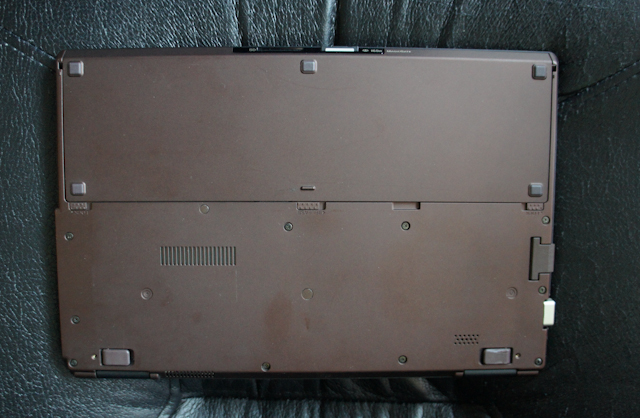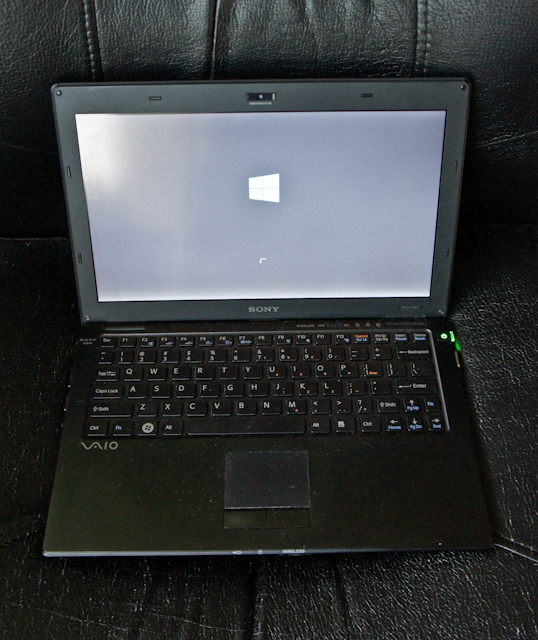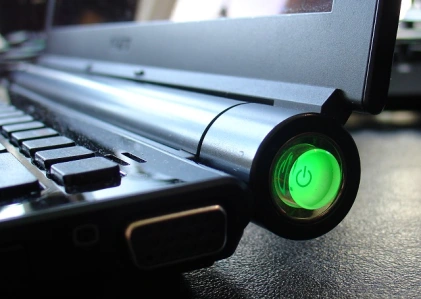
IRL Review VAIO X Ultraportable Laptop- Years ago while perusing Notebookreview.com and reading Laptop Mag’s advertisements from Sony, I ran across the VAIO X505. The X505 was an absolute mind blower of a machine- in a time when everything was Pentium 4 (with hyperthreading!) with HUGE heatsinks, and barely anything portable was with a dinky Transmeta Crusoe CPU that barely counted as a computer (i.e. the Picturebook) that you would never want to do real work on because the screen was too small, the keys were too small, or the speed was uh too small. Before our minds became skewed with the idea of the Macbook Air, and the competing Ultrabook category, there was the ultraportable category. The ultraportable category was mostly defined by screen size rather than weight- usually anthing 12 inches and under was ultraportable, 13-14 was thing and light, and 15 and above was desktop replacement. There were a few under 9 inches like the Picturebook series, and Toshiba’s Libretto, and they were usually quite expensive. Actually almost everything that was not a desktop replacement was expensive. Ultraportables were particularly expensive and usually a rare sight. At the time, Sony had their TR ultraportable line up, which was known for being a 10.4 inch laptop with an optical drive (important when optical drives were still very needed). However, it also weighed 3.1 lbs. While this was quite good for its time compared to most mainstream/desktop replacement laptops weighing upwards of 6 lbs, it wasn’t pushing the envelope. Previous premium laptops from Sony fell under the 505 line up (which I’m not intimately familiar with). Sony released the X505 which was absolutely mindboggling- it weighed 1.85 lbs (still lighter than the current wonderboy Macbook!). The specs were 10.2 x .38-.83 x 8.2 inches (width x height x depth), which was pretty insane at its time and still is 2017 wise. An XGA screen was a bit low, but nothing particular awful given the nature of screens at the time. 1.1 GHz Pentium M single core processor was a good step up from the Transmeta stuff at the time as well.

So why the flashback? Well Sony really shook the industry up at the time with this release, and never released a follow up- it was a cult hit and although originally a Japan only device, it was ordered so much through the import site Dynamism.com that it was brought over to Sony USA for the insane price of 3000 USD. It had a few quirks like the keyboard being shifted all the way to the front to make way for internal components like the HDD (1.8 inch spinning drive at 4200 rpm if i recall correctly), and no wireless or ethernet connections built in. Made of exotic carbon fiber and creating a level of lust that was ridic, Sony took its sweet time to revisit the concept in 2009. I never considered getting it due to its extremely limited specs and specific target audience that was actually never really clear, but it always stood out to me in some way because of its link to the X505 (really I should get the X505, but its specs are far too outdated to use in a modern set up now). I managed to snag one off eBay in mint condition being labeled simply as Sony netbook/small laptop, with no description of the legendary status of its build. How is the VAIO X? Read on.

Design- Obviously this is a major piece of this laptop model. The design is frankly quite impressive, but not quite as impressive as when the X505 came out. Remembering in that time that everyone was used to giant heat sinks, and super huge and heavy laptops in 2005. In 2009, the world had advanced quite a bit- Centrino had made its mark and thin and light was the norm. In addition, the netbook had absolutely killed the ultraportable concept, making them look extremely expensive for little gain. I would argue otherwise, as would maybe some notebook connoisseurs. I would argue that ultraportables typically had FAR better design, materials that were much more premium, and a just a general feel that you weren’t given bargain basement scraps to give you the cheapest price possible. Obviously the price difference was nothing to sneeze at, with ultraportables costing sometimes 5-6 times more than their netbook counterparts. So when I see the X, I see it standing out amongst netbooks as an engineering masterpiece, whereas most people would see it as a netbook. Ew. Sony actually features it in their design blog online, where I learned a lot about its history. For one, its really really tiny. Yes, its foot print is realtively similar to most netbooks. But width wise its absolutely stunning how slim it is. Furthermore, the weight still stands the test of time in 2017, and its 1.4 lbs to the Macbook’s 2.0 lbs. This is not a super fair comparison, as the Macbook does have an extra inch or so of screen size/higher resolution/far faster cpu…etc, but its also like 8 years more advanced. To me I love the tiny size of the X. Just stunning.

Its edges were actually designed to angle inwards to still give an image of ridic thinness by having the light reflect off in a specific way, and yet not resemble the Macbook Air/every other ultraportables tapered edges. The keys are chiclet, reflecting the X505’s first to the market chiclet keyboard (I reminded this often when Mac fanboys cried foul of Sony having chiclet keyboards and being copycats). The keys are much smaller than a full size board (especially the shift key!) but honestly its still a joy to type on (for smaller hands like mine), whereas the butterfly switch on the Macbook drives me nuts (despite being bigger, I can’t stand the travel on those keys). I’m actually typing the review on the X right now. I do wish the keys were backlit though, as there is none of that on here.

Sony pushed to have as many ports as possible on this, as the team said they had remorse when making the X505 and having to use dongles instead. Therefore, it has a reasonable amount of ports for a tiny machine- two USB 2.0, headphone jack, ethernet cable, VGA out (ha!), and an SD/MS card slot. The Macbook 2017 has A port (USB C). HA! Also a plus is that the AC adapter is quite tiny, so it doesn’t add too much weight. TBH I have never used the VGA out, because I think I’m pushing the CPU enough on this machine. One of the things I enjoy immensely about this machine is that I can just throw it in my bag without thought- its that freaking tiny. I would never do that with an Ultrabook. Its like putting a tablet in my bag. One other thing I love about the design- Sony engineers were given a last minute request for an extended battery and they jerry rigged something that still had lots of design cues like elevating it for ergonomics, having airflow between the chassis and the battery, and screws to make sure that it was secure in fit. The other thing is that this is positively tiny compared to its peers like the TZ. SO TINY. Its like half the size of the TZ.

Build Quality- Well here’s an interesting point. Its made of magnesium and carbon fiber (I think the deck for sure if magnesium and the rest is CF). Again, like my argument with the TZ series, I think the unibody aluminum design in the Macbook line is a better choice. Yes its not as exotic, but I never get the feeling that its going to bend/snap on those Macs including the 2017 super tiny Macbook. On the X, if you grab it in certain places, you can feel the chassis bend at a specific point (like bending a paper clip). That doesn’t feel great. Sony’s argument is that it will bend vs snap, but it doesn’t feel that great. STILL I think it feels premium- rather than expensive durable, it feels expensive delicate. Its far and above a plastic bodied netbook (I clearly hate netbooks). Honestly,this machine is holding up really well for 8 years old. No scratches, no paint rubbing off. Its great.

Usage- I said it before, but the keyboard on this is amazing- for being ridic tiny keys I am having a lot of fun typing this review out. Just enough travel to be satisfying in the keys. The ports are all easily identifiable and easy to access. Sony provides two tiny pop up feet in the bottom to elevate the laptop ever so slightly to be a bit more ergonomic (they REALLY should have done that in the Duo 13, as they did in the Duo 11). Seriously great. Overall I really have no problems with usage on this laptop. I actually think this is a better typing experience than the Duo 13, a much more powerful machine with a far bigger footprint- the biggest advantage is that the X has better key travel. Or it may be that I am expecting the typing experience to be so crappy on such a tiny keyboard that relatively its awesome. I dunno haha. Oh and that tiny trackpad is usable but meh. I do like it more than the crappy optical nub on the Duo 11, so I am happy they put it there.

Screen- this is interesting here- the screen is good. Not great. Its a matte 1366×768 screen that really is adequate for the screen size (I think a 1600×900 would have been about perfect). The screen just doesn’t pop. Its far above the shite screen of the F1 series that’s just washed out and laughably mainstream, but it doesn’t have that contrast/color pop of Sony’s other screens like the Z11 2010 edition (by far my favorite screen). Just odd, because Sony has the TZ series that is the same screen size/resolution with far more pop. Its generally fine though. I also am not impressed with viewing angles, and brightness, although its not bad enough to be a deal breaker. I just know that Sony can do better. I do want to point out that Netbooks and the original X505 really were using XGA resolution, so this X already has a step up here res wise.

Audio– HA! I think there’s a mono speaker on the bottom of the laptop. Its horrible. I find it hilarious that my cell phone has better speakers (PLURAL) than this. Not unexpected, but considering Apple mastered decent stereo speakers on their Macbook line, Sony could have done that (but really Sony has never mastered speakers in their laptops anyways).The great thing is that there is still a headphone socket here for 3.5mm jacks, whereas the Macbook has…has none. Seriously, the 3.5mm jack wasn’t that big. I really think its dumb they took it out. But I digress from the X review.

Power- Here’s the biggest clincher and what doomed the X from the start. The design team didn’t want to deal with a giant heatsink/fan set up, so they skipped out on a ULV CPU, and went with an Atom CPU (one that was a specific line up slower Atoms to reduce heat production). Its a Z550 2.0 Ghz Intel SINGLE CORE. That single core is the bain of my existence. It goes 100% way too often. The RAM is sodered on and not upgradeable, at 2GB. While o.k. for Windows 7, its really pushing the luck on Windows 10. Fortunately I forgot about increasing the Pagefile size, after trying to do ReadyBoost to increase the memory through a USB drive (turns out if you have an SSD, its not faster to make a ReadyBoost drive because USB isn’t as fast as SATA – but side note now youhave increased read writer cycles on your SSD so that might be an issue- I cycle through my computers enough that I dont think I will be too risky dangerous with this).

Here’s a side by side of the VAIO TZ and X, both ultraportables at 10.4 inches. The TZ is clearly much thicker than the X (and also boasts dual core CPU and an optical drive). You can see the TZ’s heat vent is bigger than the entire X’s thickness. That single core CPU with a bigger page file size seems to be handling smaller everyday tasks like browsing the web/studying/office work to be ok. Its clearly slower, but not unusable, which I would say it was when I didn’t have the Pagefile size at 1GB before (it was like 330mb). The funny thing is that this is so slow pre page file size that I honestly find the TZ a powerhouse in comparison (its a ULV 1.06 GHz processor). That sound hilarious to me that the ULV is a beast compared to the Atom. All relative I guess. Oh and that integrated graphics chi (GMA 500 if I remember right) is really really lame. I don’t bother with streaming content- Lisa from MobileTechReview tested high quality Hulu on the X in 2009 and it skipped, never mind HD quality that’s pretty standard now in 2017.

Battery- so interesting thing, the battery is hot swappable! I actually managed to find two standard batteries for like 20 bucks, in addition to the extended battery it came with in the auction. The standard batteries sit flush and have the weight at 1.6 lbs, while the extended battery pushes the machine up on an incline and makes it 2.2 lbs (the battery sits at an angle to give space between the machine and the batteyr for airflow. TBH I have never actually tested how battery is on this machine because I really don’t run into scenarios where I need that long battery life anymore. I do think that its not optimized for Windows 10 and is likely quite inefficient relative to the native OS Windows 7. I do remember reading it was getting 20 hours in the extended battery mode, which is really awesome pre-HaswellCPU. One of the interesting things about the battery is that you can see just how far they thought the design out here- the mouse pad sticks too far into the battery compartment, so there are no cells in the middle of the battery- but it would be too thin here durability wise without the cells- so Sony stuck a steel wire in the middle to make sure the battery doesn’t snap in half. Pretty cool. Personally I love that the battery is hot swappable compared to everything that is sealed in now.

Heat- so I am definitely confused on this one- I read they didn’t want to have a fan inside, so that’s why they went with the single core Atom CPU. Except there is definitely a fan haha. It spins up and its warm/just ever slightly annoying. I have all my settings on max though because it needs everything it can get. Honestly heat is pretty middling- its not an issue, and it doesn’t bother me- it travels slightly in the body, but really doesn’t make it too toasty, unlike my Z11. It does say don’t put on your lap, which I could see being an issue- I did read that a mat of some sort was put inside to help absorb the heat so it wouldn’t heat the chassis (which doesn’t make sense to me, because I would rather the heat escape, vs get stuck inside with the precious components.

Conclusion- honestly I love the Vaio X- its a great machine that just strives in an amazing design with size and weight specs that still amaze in 2017. Yep, it was pretty expensive in its time, and didn’t make any arguments to keep the ultraportable line up alive, It was just a nice modern take on the Vaio X505. I just wish they had pushed the envelope and put a ULV dual core instead of the Atom single core. Extra RAM would have helped too. I just find too many things about this design to be so remarkable, and the story behind its rebirth is just too interesting. Would I get it again. Yeah I would. Its pretty neat. But now I am really interested in getting the original X505 haha. I have seen people put flash drives into the X505 to make it more usable, but I don’t think it would be that great with Windows 10. The fact that I am using the X to type out this whole review in 10 is remarkable in itself (I don’t have any urge to switch computers either!).
Pros- Amazing design, amazing size, amazing weight, lots of ports, premium build, still able to run Windows 10/Cons- really underpowered and really expensive, just ok screen.
